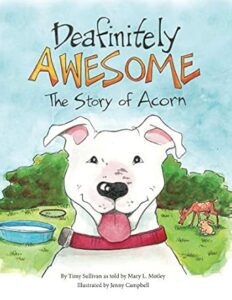
Kids 4 Paws
Family/Children’s Education Program
You can utilize our programs and tailor them to fit your needs, expanding on them or even using them to create a “camp” for kids in the summer time to get your community into your shelter building. While liability sometimes prevents shelters from allowing children to handle dogs in the facility, they can do other things – fill Kongs with peanut butter, make enrichment toys, draw pictures of the dogs, write adoption profiles, hold fundraiser or supply-drives, assist at adoption events, maybe spruce up a play yard. Kids want to help and by making the shelter a welcoming place that’s where they will go when the time comes for them to get their own dogs.
Purpose of Family/Children’s Education Program:
- To reduce the number of dogs that end up in shelters due to biting children, by educating the community how to safely interact with dogs.
- To raise awareness about rescue/shelter dogs.
- A program shelters can use to benefit their community and gain exposure for their shelter/rescue.
Rationale: According to the Center for Disease Control and Prevention, 4.5 million Americans are bitten by dogs each year. Approximately half of these are children.
While people are waiting for the program to begin, if you have one, show a video or PowerPoint presentation of the work that you do. Coloring pages are available to distribute to children. Have parents complete the Photography Waiver if you are planning on taking photographs at the event (see Appendix). If you are presenting at a library, ask the librarian (in advance) to pull some books about dogs, particularly rescue stories, if available.
Introduce Who Will Let the Dogs Out? (Or introduce your Shelter/rescue organization presenting the program)
At Who Will Let the Dogs Out: Affectionately called Waldo, we share the faces and stories of the forgotten dogs and the heroes fighting for them through words, photographs, video, and most recently, film. We travel to shelters, rescues, and dog pounds to learn more, raise awareness, and inspire change. So far, we have been to 73 organizations in 11 states.
Why are we doing this program? Even a friendly dog or family pet can be unpredictable. Any dog can bite if it is provoked or suddenly surprised. We believe that if we “listen” to their body language/warnings, bites and injuries can be prevented. Many dogs end up in shelters because they have bitten a child. In most cases, the bite is not even the fault of the dog and could have been avoided. We want to teach children, and their families, how to interact safely with dogs and to understand and respect the signals dogs are giving through their body language. Most importantly, all interactions between dogs and children should always be closely supervised by an adult.
Introduce presenters and any dogs in attendance. Share backgrounds of the dogs, if available.
Ask children if they have ever met someone new. How would you introduce yourself to someone you don’t know? (say hi, ask if they want to play, shake hands) … you can even have the children demonstrate. (This is especially important with a younger group of children – more doing/less talking.) How can you tell if they are happy to meet you? (smile, you can tell by the expression on their face or by what they say). How could you tell if they don’t want to play, or they don’t want to interact with you? What would you do? Have the children demonstrate/discuss.
Have you ever met a dog you didn’t know? Would you do the same thing with a dog? No, of course not! They can’t speak to us or tell us what they are thinking. They actually speak their own language! They use their body language to speak to us. You might already know some dog body language. (Have children tell you some things they know, i.e., wagging their tail, etc.)
It’s important to understand what a dog is telling us so that we can stay safe and we can also respect the dog’s feelings. Today, we are going to learn how to meet an unfamiliar dog so we can be safe and avoid a dog bite. Then, after we finish, you will have a chance to practice what you’ve learned with a real dog!
Show the word WAIT. Explain that we are going to remember this word whenever we meet a new dog. Each letter means something, so let’s find out what to do!
W – W stands for the word WAIT. I know we just want to pet that dog right away, but it’s important to wait. Before you approach any dog you don’t know, make sure the dog is with its owner, and make sure the dog looks happy. Never approach any dog that is not with its owner.
How do you know if a dog looks happy? (wagging its tail, etc) You can have the children discuss/demonstrate. Add additional information to what they have identified…relaxed stance, ears perked, etc.
Sometimes dogs may not be happy. They might be scared or angry. Maybe they aren’t used to being around children and they are nervous or anxious. Maybe they are protecting their owner. What would a scared dog look like? (tail between legs, etc… add more to what they identified – yawn, licking lips, turns head away while continuing to look at you, lowers head/body). What would an angry dog look like? (showing teeth, growling, ears back, tail up – might even be wagging it slowly). If a dog looks angry or afraid, just stop and slowly and quietly walk away.
OK, now you know what the W stands for… (Kids: Wait!) That’ right, WAIT to make sure the dog is with an owner and looks happy.
The next letter in WAIT is A. A stands for ASK! Always ASK the owner for permission. What could you say? (May I please pet your dog?) You can also ask if the dog is friendly. Even if the owner says the dog is friendly, remember that sometimes they act differently than expected. You need to pay attention to the dog’s body language. If the dog doesn’t seem happy or friendly, stop and walk away slowly.
Ok, so now we know what A means – ASK the owner for permission. So, the dog looks happy, the owner says yes…can we pet the dog now? No, not yet…we still have two more letters!
After A comes I – I stands for INVITE. Invite the dog to sniff you before you touch or go toward the dog. Some dogs are uncomfortable when people face them directly, look them in the eye, or reach at them. They may be uncomfortable with loud noises or quick movements, so it’s important to be quiet and gentle when you are inviting the dog to sniff you and give you permission.
Stand alongside the dog so you aren’t looking at him. Put your hand by your side, palm down and curl your fingers under to avoid being nipped. Speak softly, don’t make quick movements. Remember, the dog doesn’t know you either! Let him sniff your hand. Let him decide if he wants you to pet him. If he doesn’t sniff your hand, be respectful of his feelings, stop and don’t touch the dog. W- Wait, A-Ask, I-Invite. If he does sniff your hand, then you are ready for the last letter!
The last letter is T. T stands for TOUCH. Always be gentle, calm and friendly. Touch the dog on his back – never on his head. Stroke the dog gently on his back toward his tail. After you pet him gently for a few seconds, stop and see his reaction. Does he like it? Does he ask for more? (look at you, nudge your hand…) If he does, then you can continue to pet his back gently. The owner may tell you how the dog enjoys being touched. Never squeeze or twist a dog’s fur, or pull or play with its tail or ears.
If he backs away, or puts his tail between his legs, he may be saying he doesn’t want to be touched. He may be uncomfortable, need more space or just be saying no. If that happens, just stop, thank the owner and walk away slowly.
Now you know how to safely meet a new dog! Remember, don’t be in a hurry when you meet a new furry! WAIT!
Read May I Pet Your Dog? By Stephanie Calmensen. Point out that the story is told by a dog named Harry. As you read, discuss/remind the children that Harry is saying some of the same things we just learned with WAIT. At the end of the book, there are some additional points about meeting a new dog and dog behavior.
Or show the read aloud online https://www.youtube.com/watch?v=ueZ1Y5MeVGU
You can also show the video How to Approach a Dog Safely
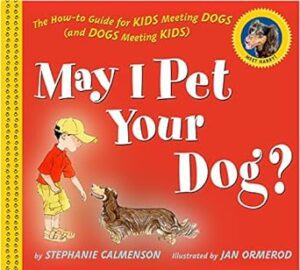 May I Pet Your Dog? is a suggestion. You may choose to read an alternate book of your preference. (See Appendix for a list of books for children.)
May I Pet Your Dog? is a suggestion. You may choose to read an alternate book of your preference. (See Appendix for a list of books for children.)
Now it’s time to practice what you learned today! You can practice on a stuffed dog or let them practice on real dogs. Make sure they remember all the steps in WAIT.
Craft: Make a toy for a shelter dog. (See Appendix for suggestions)
Be sure your craft is appropriate for the ages of the children in attendance. Young children do well with a sock bottle toy. Older children may be able to make braided toys or no-sew fleece blankets. You may need volunteers to cut and prep materials in advance, depending on the craft you choose.
Ways you can help – everyone can get involved! Share with the audience how they can help homeless dogs (volunteer, donate, foster, educate, etc. depending on your organization’s needs).
For additional information on bite prevention:
https://www.aspca.org/pet-care/dog-care/dog-bite-prevention
Kids 4 Paws
Brownie Girl Scout Pets Badge
Kids 4 Paws Mission: To educate children of all ages about safe dog interaction and the importance of dog rescue.
A 60-90 minute session with instruction, story-telling, hands-on demonstrations, crafts, and the chance to meet a rescue dog or puppy.
Introduce shelter/rescue volunteers
Lesson: Educational Program for Merit Badge (could be done in stations)
Step 1: Find out what care different pets need.
Ask who already has a pet. Take a little “survey” about what kinds of pets the girls already have. Pets are a lot of fun! They are a long-term commitment. They need to be cared for every day – they need to be fed, exercised, taken to the vet, cleaned up after and more. There are lots of pets to choose from. OPH rescues dogs (and some cats) so we will mostly talk about what it takes to care for dogs today.
CHECK OUT VIDEO FROM MIAMI DADE CO
Caring for a dog:
Dogs are such fun pets! But they can’t take care of themselves. They need their people to take care of them properly. Do you help take care of your dog? (allow kids to answer).
Dogs are living things, just like we are, and they need some of the same things we do. Let’s talk about some things dogs need to be happy and healthy.
• Safe home/shelter
• Good healthy food and clean, fresh water
• Exercise and play time
• Comfy place to sleep
• Need to go outside to potty
• Training so they know how to behave in your home and around others
• Grooming — teeth brushed, brushing, nails trimmed
• Veterinarian visits, just like we need to go to the doctor
• Love
Kids can help take care of dogs too.
Age 3-6: can help feed, water, brush and play (with supervision)
Age 6-10: can help feed, clean dog areas (like crate and toys) exercise, walk (depending on size of dog) and play (with supervision)
Age 10+: Can do all care tasks (unless it’s a very large dog)
Read: Are You Ready for Me? by Claire Buchwald and Ameila Hansen or Max Talks to Me by Claire Buchwald and Karen Ritz to reinforce concepts discussed in this lesson.
Step 2: Keep a pet comfy.
Girls make a no-sew fleece pet blanket to take home for their dog or to donate to shelter/rescue.
Step 3: Help a pet stay healthy and safe.
Do a sorting activity with the whole group. What is good for dogs? What is not good for dogs? Using pictures, children will decide what foods/activities are good or not good for dogs and attach the pictures on the correct side of the poster-sized sorting mat.
Good/Safe for Dogs
Play/exercise
Brushing teeth
Going to the vet
Brushing/grooming
Nice comfy bed
Dog treats
Bowl of fresh water
Strawberries
Rubbing dog under chin
Training
Not Good/Not Safe for Dogs
Table scraps
Chocolate
Grapes
Child pulling tail or ears
Patting/approaching with hand on top of head
Onions/garlic
Poisonous plants
Some plants are poisonous
Getting face to face with dog
Hugging / kissing a dog
Step 4: Make a pet feel loved.
Make a dog toy – Make a craft: choose an option from the Kids 4 Paws craft list.
Explain that these toys are for dogs in shelters and foster homes. (allow kids to take toys home for their own dogs if they want).
EX. waterbottle/socks (with messages), braided fleece, tennis ball tug toy
Step 5: Feed a pet.
What will it cost to take feed a medium-sized dog?
Food ranges from $1.00 per pound (lower quality brands) to over $3.00 per pound (high quality / limited ingredients, etc.). Use the average $2.00 to make calculations easier for younger children (up to grade 2). There are about 4 cups in 1 pound of dog food. If a medium-sized dog eats 2 cups of food per day, how much will it cost to feed the dog per day? Per week? Per month (30 days)? Depending on the age of the Scouts, they may be able to do the calculations with little or no support.
Other Programs/Activities for Kids
Moore County Program Teaches Young Students About Responsible Pet Care
The Mission of the Moore County Citizens’ Pet Responsibility Committee (PRC) in North Carolina is to support the Moore County Commissioners in addressing the pet overpopulation crisis in Moore County.
Launched in 2008 the PRC pilot program aimed to educate over 1,000 fourth grade students in Moore County each year about pet responsibility. Today, this program is an integral part of the curriculum, reaching more than 1,200 students annually across all public schools in Moore County, as well as five major private and charter schools.
The PRC Pet Responsibility Program is presented as an integral part of Moore County Schools’ Character Education Program focusing on the values of good judgment, integrity, kindness, perseverance, respect and responsibility. Each year, volunteers present the program to fourth graders once a week over a six-week period, working closely with Moore County Animal Services Deputies to enhance educational efforts.
A highlight of the program is the involvement of accredited therapy dogs and their handlers, who help celebrate the joy of a well-trained, well-cared for and loved dogs. These therapy dog teams also support the Reading Tails Program, which assists elementary school students in improving their reading skills.
PRC is a nonprofit organization and is happy to share lesson plans with others interested in starting a similar program in their communities. For more information, please contact Angela North Zumwalt at (910) 949-9953 or via email at angelazumwalt@earthlink.net.
Cat Tails
 Invite kids to come to the shelter and read to cats and/or set up this reading program at your local library if there is a safe place for cats. Some shelters include story time along with adoption events inviting a volunteer to read stories about animals to children. The Adoption Coordinator and Shelter Manager at the Onslow County Animal Shelter, NC visited the local shelter with friendly adult cats and kittens. Kids at the shelter took turns holding, petting, and reading to the cats and also learned about the adoption and foster programs at the shelter.
Invite kids to come to the shelter and read to cats and/or set up this reading program at your local library if there is a safe place for cats. Some shelters include story time along with adoption events inviting a volunteer to read stories about animals to children. The Adoption Coordinator and Shelter Manager at the Onslow County Animal Shelter, NC visited the local shelter with friendly adult cats and kittens. Kids at the shelter took turns holding, petting, and reading to the cats and also learned about the adoption and foster programs at the shelter.
Caturday
Encourage kids to come and make cat-themed crafts while hanging out with adoptable cats at the shelter.
Creative Kids Can Help Find Homes for Animals
A volunteer with the Redland Rock Pit Abandoned Dogs Project, FL, who is a teacher, created an art project to help get homeless dogs adopted. Each student was assigned a dog and created artwork to accompany each dog’s bio. The artwork drew attention to the dogs and the hope is that it will help in finding them forever loving homes. This is also a wonderful project for scout troops and humane education classes. Every year an English teacher at the Northside Middle School in Roanoke, VA has her students write poems highlighting the dogs at the Regional Center for Animal Care & Protection, VA. The poems include photos of the dogs and are shared on social media helping to get more exposure for the dogs.
Host a “Pets and Tots” Class
Hosting young kids at the shelter and teaching them how to interact with animals is a wonderful bonding and learning experience. The Humane Society of Tampa Bay added a “Pets and Tots” Class to its Humane Education Program. Parents, grandparents, and guardians are invited to bring children age 4 and under to the shelter for this monthly event. The hourly program features storytime, an activity, and time for the children to interact with animals.
Partner With Tails That Teach
Tails That Teach is a nonprofit that inspires young children to be kind to pets and people. The organization focuses mainly on ages 3 through 8 and partners with animal organizations and elementary schools that offer humane education classes by providing compassion-centered books free of charge. Humane educators and qualifying animal rescue organizations can also order free Kids Activity Books. For more information on partnering with Tails That Teach email lisa@tailsthatteach.com.
Provide Coloring Pages to Family Restaurant
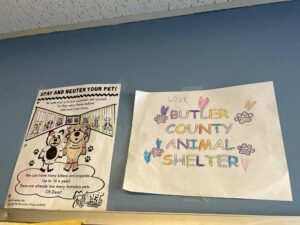 The Butler County Animal Shelter, KY set up coloring pages at a local family restaurant. Once the coloring is completed, the kids can bring the page to the shelter to help decorate the lobby. Each child who brings in a completed page can choose a prize from a chest full of toys. This is just one small step towards the shelter’s goal to have a humane education learning program that teaches the next generation what it means to be an animal welfare warrior.
The Butler County Animal Shelter, KY set up coloring pages at a local family restaurant. Once the coloring is completed, the kids can bring the page to the shelter to help decorate the lobby. Each child who brings in a completed page can choose a prize from a chest full of toys. This is just one small step towards the shelter’s goal to have a humane education learning program that teaches the next generation what it means to be an animal welfare warrior.
Start a Junior Volunteer Club
The Montgomery Humane Society, AL launched a Junior Volunteer Club for children ages 8 through 15. The purpose of the club is to encourage youngsters to assist shelter staff and volunteers while learning the importance of service and how to care for animals so they live happy and healthy lives. Members of the Junior Volunteer Club develop respect and compassion for animals. Club meetings are held monthly at the shelter and members along with their parents work on projects that help the shelter.
Teach Kids How to Humanely Care for Animals
If your kids have a passion for animals enrolling them in an animal-themed summer camp might be a great fit. For example, the Fredericksburg SPCA hosts a summer Compassionate Care Camp offering a week of exciting activities, learning opportunities, and hands-on experiences with pets. The focus of this camp is to educate kids on humane practices, responsible care, and treatment of animals while also providing hands-on experiences to those interested in animal career fields.
Memphis Animal Services, TN partnered with Memphis Public Libraries to offer Pet-Cents Academy – a kids’ class on responsible pet ownership. The program is designed to teach youngsters the basics of pet care, kindness, and compassion.
The Red Rover Readers Education program provides educators with a curriculum and other resources to teach children empathy skills. The nonprofit publishes Kind News magazine (ages 8 and up) and Kind News, Jr. (ages 5 to 7) on animal behavior, issues affecting animals, how to care for pets, and how to take action to improve the lives of animals. The magazines are delivered five times a years and subscriptions are $10 per year. Classroom subscriptions are also available.
Visit Schools with Shelter Dogs
Members of the Paws to Care rescue group, TN visit local elementary schools with shelter dogs and speak to students about helping animals. The group celebrated Read Across America in 2025 by visiting the Trimble Elementary School and reading to the students from a book about animals who need homes.
Dog Toys / Crafts for Kids to Make
There are many fun crafts children can make for shelter animals. These are just a few suggestions. There are many great ideas online as well.
 Bottle Toy Craft: Prior to event, remove caps and cap rings from the plastic bottles to prevent a choking hazard. The rings can be difficult. Pliers are helpful for this job. To make this toy, simply insert the bottle (bottom first) into the sock and tie a not. Children enjoy decorating the socks with pictures and/or messages to shelter dogs. Be sure to use non-toxic markers! Small children are able to do this with some adult assistance.
Bottle Toy Craft: Prior to event, remove caps and cap rings from the plastic bottles to prevent a choking hazard. The rings can be difficult. Pliers are helpful for this job. To make this toy, simply insert the bottle (bottom first) into the sock and tie a not. Children enjoy decorating the socks with pictures and/or messages to shelter dogs. Be sure to use non-toxic markers! Small children are able to do this with some adult assistance.
 Braided Toy Craft: These are a wonderful way to recycle old tee shirts! Prior to event, cut shirts into strips. These are not suitable for small children, but are fun for upper elementary aged children or older. https://thecraftyblogstalker.com/diy-dog-chew-toy-tutorial/
Braided Toy Craft: These are a wonderful way to recycle old tee shirts! Prior to event, cut shirts into strips. These are not suitable for small children, but are fun for upper elementary aged children or older. https://thecraftyblogstalker.com/diy-dog-chew-toy-tutorial/
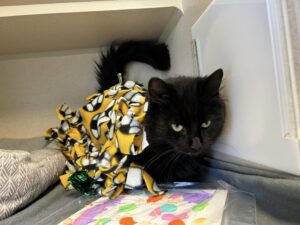 No-sew Fleece Blankets: Prior to event, fleece needs to be precut so children only have to do the knot tying. This is not for small children, suitable for children 8+ with some adult assistance. Older children, teens and adults could enjoy this activity. No-sew blankets are a great project for scout troops. For example, the local Boy Scout Troop made fleece tie blankets for the cats at the Butler Animal Shelter, KY. https://www.momsmagicalmiles.com/no-sew-fleece-blanket-for-your-dog/
No-sew Fleece Blankets: Prior to event, fleece needs to be precut so children only have to do the knot tying. This is not for small children, suitable for children 8+ with some adult assistance. Older children, teens and adults could enjoy this activity. No-sew blankets are a great project for scout troops. For example, the local Boy Scout Troop made fleece tie blankets for the cats at the Butler Animal Shelter, KY. https://www.momsmagicalmiles.com/no-sew-fleece-blanket-for-your-dog/
For more ideas on how young people can help their local shelters visit our Resource Guide/Community Outreach and Education page.
Appendix
Reading Resources for Kids
There are many excellent books available to teach children about dog safety and rescue/shelter animals. Check with your local library for additional resources.
125 Pet Rescues: From Pound to Palace: Homeless Pets Made Happy – National Geographic Kids
Acorn’s DEAFinitely Awesome Dictionary of Signs – Mary L. Motley and Carol Peter
Are You Ready for Me? – Claire Buchwald
Be a Dog’s Best Friend: A Safety Guide for Kids – Renee Payne and Jennifer Gladysz
Buddy Unchained – Daisy Bix
Deafinitely Awesome: The Story of Acorn – Mary L. Motley and Timy Sullivan (proceeds from the sale of this book benefit the City Dogs Cleveland)
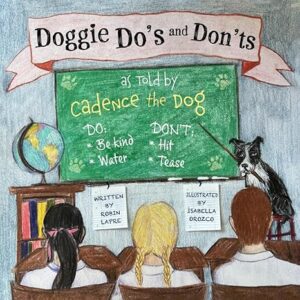 Doggie Do’s and Don’ts as Told by Cadence the Dog – Robin Labre
Doggie Do’s and Don’ts as Told by Cadence the Dog – Robin Labre
Doggy Do’s and Don’ts – Emily Levine, DVM, DACVB
Don’t Lick the Dog: Making Friends with Dogs – Wendy Wahman
Hey Dog! Let’s Talk! – Wendy Keefer
Hobbes Goes Home – Tami Crupi Zeman and Shaunna Peterson
May I Pet Your Dog?: The How-to Guide for Kids Meeting Dogs (and Dogs Meeting Kids) – Stephanie Calmenson
Making Friends with Dogs: Acorn’s Awesome Activity Book – Mary L. Motley and Christine Good
Max Talks to Me – Claire Buchwald
Rescuing Rover: Saving America’s Dogs – Raymond Bial